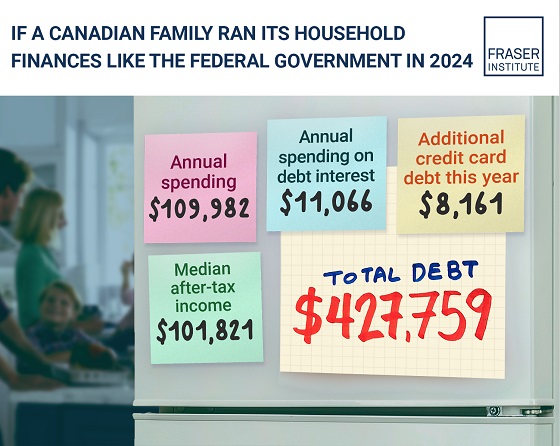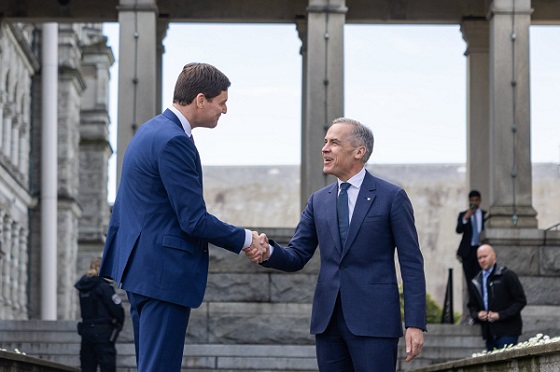Economy
If Canadian families spent and borrowed like the federal government, they would be $427,759 in debt

From the Fraser Institute
By Grady Munro and Jake Fuss
If the median Canadian family spent and borrowed like the federal government, they would already be $427,759 in debt and continuing to borrow, finds a new study published today by the Fraser Institute.
“If the median family in Canada spent and borrowed like the federal government, they would be in serious financial trouble,” said Grady Munro, a Fraser Institute policy analyst and co-author of Understanding the Scale of Canada’s Federal Deficit.
The $39.8 billion deficit expected by Ottawa in 2024/25 represents the 17th consecutive annual federal deficit, with continued deficits expected into the foreseeable future, eventually resulting in higher taxes for Canadians.
Continuous annual borrowing by Ottawa to finance increased spending has driven federal total debt from 53.0 per cent of the economy ($1.1 trillion) in 2014/15 up to an expected 69.8 per cent ($2.1 trillion) in 2024/25.
To put this into perspective, the study’s analysis offers an example of what a median family’s household finances would look like if they were to spend and borrow like the federal government in 2024.
The study found that the median Canadian family in 2024 would spend $109,982 while only earning $101,821, meaning that it would borrow $8,161 just to pay for its normal spending. This $8,000-plus in additional debt is on top of the $427,759 in existing debt the family would already hold based on previous borrowing.
Illustrative of the burden of debt, $11,066 of the family’s income, representing almost 11 per cent, would be spent on just the interest costs of existing debt.
“Unlike most households, where debt is often offset by assets such as a home or investments, the federal government has little in the way of assets to offset its enormous debt,” said Jake Fuss, director of fiscal policy at the Fraser Institute and coauthor. “And it’s important to note that this government debt burden on Canadian families does not include the burden of provincial and municipal government debt, which depending on one’s location, can be significant.”

- For many years the federal government’s approach to government finances has relied on spending-driven deficits and a growing debt burden, causing a deterioration in the state of federal finances.
- While deficits can sometimes be justified in certain circumstances, perpetual spending-driven deficits have become the norm rather than a temporary exception for the federal government. The $39.8 billion deficit expected in 2024/25 is the 17th consecutive annual deficit, and deficits are expected to continue into the foreseeable future.
- Deficits have helped drive federal gross debt from 53.0% of the economy ($1.1 trillion) in 2014/15 up to an expected 69.8% ($2.1 trillion) in 2024/25.
- This increase in the level of federal debt comes with costs and will result in higher taxes on Canadians.
- It may be hard to comprehend the scale of the deficits and debt, so to contextualize the current state of federal finances this bulletin provides an example of what a median family’s household budget would look like in 2024 if it managed its finances the way the federal government does.
- The median family earning $101,821 in 2024 would be spending $109,982 if it spent the way the federal government does. To cover the difference, it would put $8,161 on a credit card, despite already being $427,759 in debt.
- Of the total amount spent, $11,066 would go towards interest on the debt his year. Simply put, a Canadian family that chose to spend like the federal government would be in financial trouble.
Authors:
conflict
Middle East clash sends oil prices soaring

This article supplied by Troy Media.
 By Rashid Husain Syed
By Rashid Husain Syed
The Israel-Iran conflict just flipped the script on falling oil prices, pushing them up fast, and that spike could hit your wallet at the pump
Oil prices are no longer being driven by supply and demand. The sudden escalation of military conflict between Israel and Iran has shattered market stability, reversing earlier forecasts and injecting dangerous uncertainty into the global energy system.
What just days ago looked like a steady decline in oil prices has turned into a volatile race upward, with threats of extreme price spikes looming.
For Canadians, these shifts are more than numbers on a commodities chart. Oil is a major Canadian export, and price swings affect everything from
provincial revenues, especially in Alberta and Saskatchewan, to what you pay at the pump. A sustained spike in global oil prices could also feed inflation, driving up the cost of living across the country.
Until recently, optimism over easing trade tensions between the U.S. and China had analysts projecting oil could fall below US$50 a barrel this year. Brent crude traded at US$66.82, and West Texas Intermediate (WTI) hovered near US$65, with demand growth sluggish, the slowest since the pandemic.
That outlook changed dramatically when Israeli airstrikes on Iranian targets and Tehran’s counterattack, including hits on Israel’s Haifa refinery, sent shockwaves through global markets. Within hours, Brent crude surged to US$74.23, and WTI climbed to US$72.98, despite later paring back overnight gains of over 13 per cent. The conflict abruptly reversed the market outlook and reintroduced a risk premium amid fears of disruption in the world’s critical oil-producing region.
Amid mounting tensions, attention has turned to the Strait of Hormuz—the narrow waterway between Iran and Oman through which nearly 20 per cent of the world’s oil ows, including supplies that inuence global and
Canadian fuel prices. While Iran has not yet signalled a closure, the possibility
remains, with catastrophic implications for supply and prices if it occurs.
Analysts have adjusted forecasts accordingly. JPMorgan warns oil could hit US$120 to US$130 per barrel in a worst-case scenario involving military conflict and a disruption of shipments through the strait. Goldman Sachs estimates Brent could temporarily spike above US$90 due to a potential loss of 1.75 million barrels per day of Iranian supply over six months, partially offset by increased OPEC+ output. In a note published Friday morning, Goldman Sachs analysts Daan Struyven and his team wrote: “We estimate that Brent jumps to a peak just over US$90 a barrel but declines back to the US$60s in 2026 as Iran supply recovers. Based on our prior analysis, we estimate that oil prices may exceed US$100 a barrel in an extreme tail scenario of an extended disruption.”
Iraq’s foreign minister, Fuad Hussein, has issued a more dire warning: “The Strait of Hormuz might be closed due to the Israel-Iran confrontation, and the world markets could lose millions of barrels of oil per day in supplies. This could result in a price increase of between US$200 and US$300 per barrel.”
During a call with German Foreign Minister Johann Wadephul, Hussein added: “If military operations between Iran and Israel continue, the global market will lose approximately five million barrels per day produced by Iraq and the Gulf states.”
Such a supply shock would worsen inflation, strain economies, and hurt both exporters and importers, including vulnerable countries like Iraq.
Despite some analysts holding to base-case forecasts in the low to mid-US$60s for 2025, that optimism now looks fragile. The oil market is being held hostage by geopolitics, sidelining fundamentals.
What happens next depends on whether the region plunges deeper into conflict or pulls back. But for now, one thing is clear: the calm is over, and oil is once again at the mercy of war.
Toronto-based Rashid Husain Syed is a highly regarded analyst specializing in energy and politics, particularly in the Middle East. In addition to his contributions to local and international newspapers, Rashid frequently lends his expertise as a speaker at global conferences. Organizations such as the Department of Energy in Washington and the International Energy Agency in Paris have sought his insights on global energy matters.
Troy Media empowers Canadian community news outlets by providing independent, insightful analysis and commentary. Our mission is to support local media in helping Canadians stay informed and engaged by delivering reliable content that strengthens community connections and deepens understanding across the country.
Alberta
Alberta’s grand bargain with Canada includes a new pipeline to Prince Rupert

From Resource Now
Alberta renews call for West Coast oil pipeline amid shifting federal, geopolitical dynamics.
Just six months ago, talk of resurrecting some version of the Northern Gateway pipeline would have been unthinkable. But with the election of Donald Trump in the U.S. and Mark Carney in Canada, it’s now thinkable.
In fact, Alberta Premier Danielle Smith seems to be making Northern Gateway 2.0 a top priority and a condition for Alberta staying within the Canadian confederation and supporting Mark Carney’s vision of making Canada an Energy superpower. Thanks to Donald Trump threatening Canadian sovereignty and its economy, there has been a noticeable zeitgeist shift in Canada. There is growing support for the idea of leveraging Canada’s natural resources and diversifying export markets to make it less vulnerable to an unpredictable southern neighbour.
“I think the world has changed dramatically since Donald Trump got elected in November,” Smith said at a keynote address Wednesday at the Global Energy Show Canada in Calgary. “I think that’s changed the national conversation.” Smith said she has been encouraged by the tack Carney has taken since being elected Prime Minister, and hopes to see real action from Ottawa in the coming months to address what Smith said is serious encumbrances to Alberta’s oil sector, including Bill C-69, an oil and gas emissions cap and a West Coast tanker oil ban. “I’m going to give him some time to work with us and I’m going to be optimistic,” Smith said. Removing the West Coast moratorium on oil tankers would be the first step needed to building a new oil pipeline line from Alberta to Prince Rupert. “We cannot build a pipeline to the west coast if there is a tanker ban,” Smith said. The next step would be getting First Nations on board. “Indigenous peoples have been shut out of the energy economy for generations, and we are now putting them at the heart of it,” Smith said.
Alberta currently produces about 4.3 million barrels of oil per day. Had the Northern Gateway, Keystone XL and Energy East pipelines been built, Alberta could now be producing and exporting an additional 2.5 million barrels of oil per day. The original Northern Gateway Pipeline — killed outright by the Justin Trudeau government — would have terminated in Kitimat. Smith is now talking about a pipeline that would terminate in Prince Rupert. This may obviate some of the concerns that Kitimat posed with oil tankers negotiating Douglas Channel, and their potential impacts on the marine environment.
One of the biggest hurdles to a pipeline to Prince Rupert may be B.C. Premier David Eby. The B.C. NDP government has a history of opposing oil pipelines with tooth and nail. Asked in a fireside chat by Peter Mansbridge how she would get around the B.C. problem, Smith confidently said: “I’ll convince David Eby.”
“I’m sensitive to the issues that were raised before,” she added. One of those concerns was emissions. But the Alberta government and oil industry has struck a grand bargain with Ottawa: pipelines for emissions abatement through carbon capture and storage.
The industry and government propose multi-billion investments in CCUS. The Pathways Alliance project alone represents an investment of $10 to $20 billion. Smith noted that there is no economic value in pumping CO2 underground. It only becomes economically viable if the tradeoff is greater production and export capacity for Alberta oil. “If you couple it with a million-barrel-per-day pipeline, well that allows you $20 billion worth of revenue year after year,” she said. “All of a sudden a $20 billion cost to have to decarbonize, it looks a lot more attractive when you have a new source of revenue.” When asked about the Prince Rupert pipeline proposal, Eby has responded that there is currently no proponent, and that it is therefore a bridge to cross when there is actually a proposal. “I think what I’ve heard Premier Eby say is that there is no project and no proponent,” Smith said. “Well, that’s my job. There will be soon. “We’re working very hard on being able to get industry players to realize this time may be different.” “We’re working on getting a proponent and route.”
At a number of sessions during the conference, Mansbridge has repeatedly asked speakers about the Alberta secession movement, and whether it might scare off investment capital. Alberta has been using the threat of secession as a threat if Ottawa does not address some of the province’s long-standing grievances. Smith said she hopes Carney takes it seriously. “I hope the prime minister doesn’t want to test it,” Smith said during a scrum with reporters. “I take it seriously. I have never seen separatist sentiment be as high as it is now. “I’ve also seen it dissipate when Ottawa addresses the concerns Alberta has.” She added that, if Carney wants a true nation-building project to fast-track, she can’t think of a better one than a new West Coast pipeline. “I can’t imagine that there will be another project on the national list that will generate as much revenue, as much GDP, as many high paying jobs as a bitumen pipeline to the coast.”
-

 Alberta2 days ago
Alberta2 days agoAlberta’s grand bargain with Canada includes a new pipeline to Prince Rupert
-

 Bruce Dowbiggin1 day ago
Bruce Dowbiggin1 day agoWOKE NBA Stars Seems Natural For CDN Advertisers. Why Won’t They Bite?
-

 Business2 days ago
Business2 days agoCarney’s European pivot could quietly reshape Canada’s sovereignty
-

 Health21 hours ago
Health21 hours agoLast day and last chance to win this dream home! Support the 2025 Red Deer Hospital Lottery before midnight!
-

 Crime12 hours ago
Crime12 hours agoUK finally admits clear evidence linking Pakistanis and child grooming gangs
-

 Business17 hours ago
Business17 hours agoCarney praises Trump’s world ‘leadership’ at G7 meeting in Canada
-

 Energy1 day ago
Energy1 day agoCould the G7 Summit in Alberta be a historic moment for Canadian energy?
-

 Crime1 day ago
Crime1 day agoMinnesota shooter arrested after 48-hour manhunt





